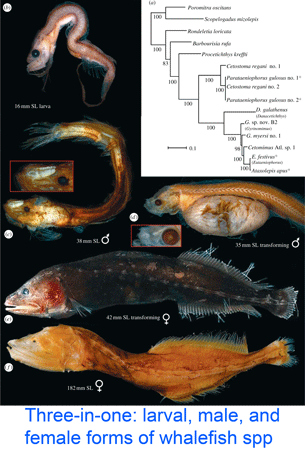DNA sorts out bewildering morphology
 DNA helps flag genetically divergent forms that may represent cryptic species and is equally valuable the other way around: in linking morphologically diverse forms that occur within species. In 20 jan 2009 Biol Lett, researchers from National Museum of Natural History, Washington, DC; Australian Museum, Sydney; Virginia Institute of Marine Science; University of Tokyo; and Natural History Museum, Tokyo, solve the mystery of “the most extreme example of ontogenetic morphoses and sexual dimorphism in vertebrates.”
DNA helps flag genetically divergent forms that may represent cryptic species and is equally valuable the other way around: in linking morphologically diverse forms that occur within species. In 20 jan 2009 Biol Lett, researchers from National Museum of Natural History, Washington, DC; Australian Museum, Sydney; Virginia Institute of Marine Science; University of Tokyo; and Natural History Museum, Tokyo, solve the mystery of “the most extreme example of ontogenetic morphoses and sexual dimorphism in vertebrates.”
Johnson and colleagues examined specimens of small (body size 4-408 mm) deep water (1000-4000m) fishes thought to represent 3 families in the order Stephanoberyciformes (whalefish and relatives). The authors analyzed morphology and whole mitochondrial genomes from 34 individuals of 16 species including representatives of all 5 whalefish families. They found three whalefish “families” are one: “Mirapinnidae (tapetails), Megalomycteridae (bignose fishes), and Cetomimidae (whalefishes), are larvae, males and females, respectively of a single family Cetomimidae.” These are strange-looking fish–the males, which do not feed as adults, are sustained by enormous livers, and the minute larvae have streamers up to 75 cm. For fun, see deep ocean video of live female whalefish swimming (and narration of the amazed icthyologists) in supplementary material. Next up is to link the three life stages of each species; here DNA will help along with meristic data (quantitative features such as number of fins or scales).
This entry was posted on Tuesday, March 31st, 2009 at 11:38 am and is filed under General. You can follow any responses to this entry through the RSS 2.0 feed. Both comments and pings are currently closed.
April 12th, 2009 at 1:53 pm
That is unbelievable that they don’t feed as adults. I’ve never heard of an animal sustaining themselves on their liver alone.